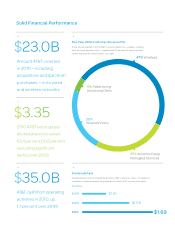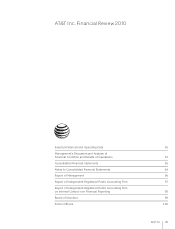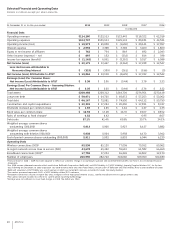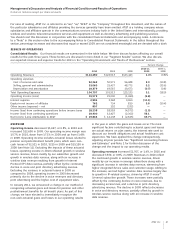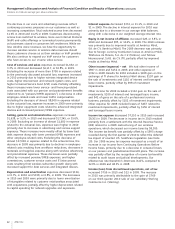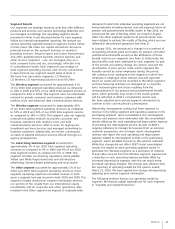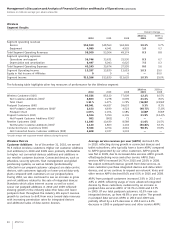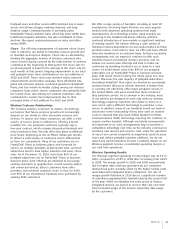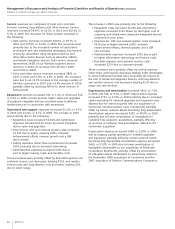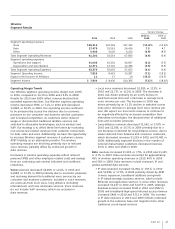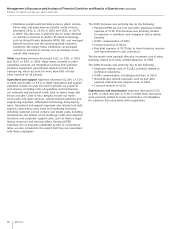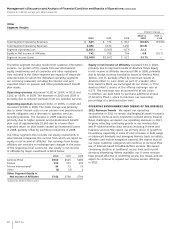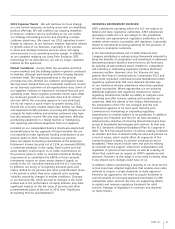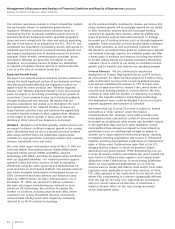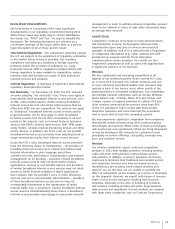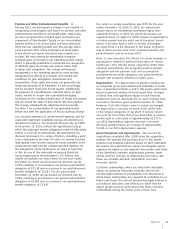AT&T Wireless 2010 Annual Report Download - page 37
Download and view the complete annual report
Please find page 37 of the 2010 AT&T Wireless annual report below. You can navigate through the pages in the report by either clicking on the pages listed below, or by using the keyword search tool below to find specific information within the annual report.
AT&T Inc. 35
We offer a large variety of handsets, including at least 18
smartphones (including Apple iPhones, our most popular
models) with advanced operating systems from eight
manufacturers. As technology evolves, rapid changes are
occurring in the handset and device industry, with the
continual introduction of new models or significant revisions
of existing models. We believe offering a wide variety of
handsets reduces dependence on any single product as these
products evolve. From time to time, we offer and have offered
attractive handsets on an exclusive basis. As these exclusivity
arrangements end, we expect to continue to offer such
handsets (based on historical industry practice), and we
believe our service plan offerings will help to retain our
customers by providing incentives not to move to a new
carrier. As noted above, more than 80% of our postpaid
subscribers are on FamilyTalk® Plans or business discount
plans that would involve moving the whole group to a new
carrier. Moreover, the vast majority of postpaid subscribers
(including FamilyTalk® Plan users) are allowed to accumulate
unused minutes (known as rollover minutes), a feature that
is currently not offered by other major postpaid carriers in
the United States, and users would lose these minutes if
they switched carriers. As is common in the industry, most
of our phones are designed to work only with our wireless
technology, requiring customers who desire to move to a
new carrier with a different technology to purchase a new
device. In addition, many of our handsets would not work or
would lose some functionality if they were used on another
carrier’s network that also used Global System for Mobile
Communications (GSM) technology, requiring the customer to
acquire another handset. Although exclusivity arrangements
are important to us, such arrangements may not provide a
competitive advantage over time, as the industry continues to
introduce new devices and services. Also, while the expiration
of any of our current exclusivity arrangements could increase
churn and reduce postpaid customer additions, we do not
expect any such termination to have a material impact on our
Wireless segment income, consolidated operating margin or
our cash from operations.
Wireless Operating Results
Our Wireless segment operating income margin was 26.1% in
2010, compared to 25.8% in 2009 after increasing from 23.6%
in 2008. The margin growth in 2010 and 2009 was primarily
due to higher data revenues generated by our customers
during those years, partially offset by the higher selling costs
associated with integrated device activations. The rate of
margin growth flattened in 2010 due to a significant number
of customers upgrading their handsets during the second half
of the year. While we subsidize the sales prices of various
integrated devices, we expect to recover that cost over time
from increased usage of the devices (especially data usage
by the customer).
Postpaid voice and other service ARPU declined due to lower
access and airtime charges, roaming revenues, and long-
distance usage. Continued growth in our family plans
(FamilyTalk® Plans) customer base, which has lower ARPU than
traditional postpaid customers, has also contributed to these
declines. We expect continued pressure on voice and other
service ARPU.
Churn The effective management of customer churn (churn
rate) is critical to our ability to maximize revenue growth and
to maintain and improve margins. Churn rate is calculated by
dividing the aggregate number of wireless customers who
cancel service during a period by the total number of wireless
customers at the beginning of that period. The churn rate for
an annual period is equal to the average of the churn rate for
each month of that period. Ongoing improvement in our total
and postpaid churn rates contributed to our net additions in
2010 and 2009. These churn rate declines reflect network
enhancements and broader coverage, more affordable rate
plans and exclusive devices, continued growth in FamilyTalk®
Plans, and free mobile-to-mobile calling among our wireless
customers. Data-centric device customers, who generally have
the lowest churn rate among our wireless customers, also
contributed to overall churn improvement due to their
increased share of net additions for 2010 and 2009.
Wireless Customer Relationships
The wireless industry continues to mature. Accordingly,
we believe that future wireless growth will increasingly
depend on our ability to offer innovative services and
devices. To attract and retain customers, we offer a wide
variety of service plans in addition to offering a broad
handset line. Our postpaid customers typically sign a
two-year contract, which includes discounted handsets and
early termination fees. We also offer data plans at different
price levels, beginning as low as fifteen dollars per month,
to attract a wide variety of customers and to differentiate
us from our competitors. Many of our customers are on
FamilyTalk® Plans or business plans, which provide for
service on multiple handsets at discounted rates, and such
subscribers tend to have higher retention and lower churn
rates. As of December 31, 2010, more than 80% of our
postpaid subscribers are on FamilyTalk® Plans or business
discount plans. Such offerings are intended to encourage
existing customers to upgrade their current services and/or
add connected devices, attract customers from other
providers, and minimize customer churn. In fact, for 2010,
over 65% of our smartphone handsets were purchased by
existing AT&T customers.


